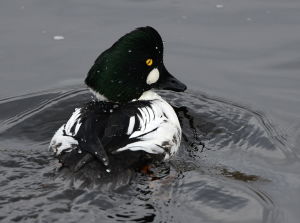
Common goldeneye just surfacing from a dive. You can clearly see the nictitating membrane.
photo by Gouldingken creative commons
The best way I know of to get a rare bird to fly the coop is to write about it. So by the time you see this article the two drake common goldeneyes that have been hanging out at Lake Junaluska for the past week or so will likely have vanished. But they have been consistently sighted along the shoreline on the “cross-side” of the lake a couple of hundred yards from the dam.
Common goldeneyes are uncommon to rare at Lake J. I wouldn’t be surprised if goldeneyes visited the lake each fall/winter season, but they usually just drop in for a rest – here today, gone tomorrow – so someone has to be in the right place at the right time to record them.
These two birds make the third sighting of c. goldeneyes this season. There was one from mid to late December; one during count week (12/30/14 to 1/5/15) of the Balsam Christmas Bird Count and now these two, which have been with us for a long time in goldeneye-days.
Common goldeneyes nest across Canada and Alaska down to Minnesota, Michigan and the northeastern U.S. They are cavity nesters and depend in large part on cavities from large woodpeckers like pileateds and flickers. They will also use natural cavities and/or open depressions created by broken limbs. C. goldeneyes have strong site fidelity and will reuse the same cavity. Females will lay their eggs in the nests of other females, including other species like wood ducks and hooded mergansers.
Common goldeneyes are some of the latest fall migrants and they often overwinter as far north as open water allows. Eastern birds overwinter down the eastern seaboard from Newfoundland to Florida and inland as far as the Mississippi River.
These handsome ducks get their name from their golden yellow iris. Hatchlings have brownish-grey eyes that turn purple to blue to blue-green as they age, they don’t acquire “golden” eyes until they are adults.
Adult males are basically black on top and tail, with an iridescent head that shines from black to green depending on the light. There is a round white cheek patch between the eye and the bill. They are clean white on flanks, breast and belly. The female has a chocolate-brown head and is grayish on back and breast. Her bill is black at the base and tipped with yellow. Juveniles can be quite variable but are generally similar to females with brownish heads and grayish bodies.
It seems to be a pretty good year for common goldeneyes across the region. They have bee reported from the Newport River in Carteret County and Lake Crabtree in Wake County – both in North Carolina and from Donnelley WMA in South Carolina so far, this month.
Common goldeneyes feed on aquatic insects, small fishes, crustaceans and aquatic plants, which they obtain by diving. And like all diving ducks they have a clear nictitating membrane that covers the eye when they dive. I mention this so you can check it out in the photo.
As I was finishing this on 1/19 – I came across a post on Carolinabirds, noting that the c. goldeneyes are still at Lake J.
